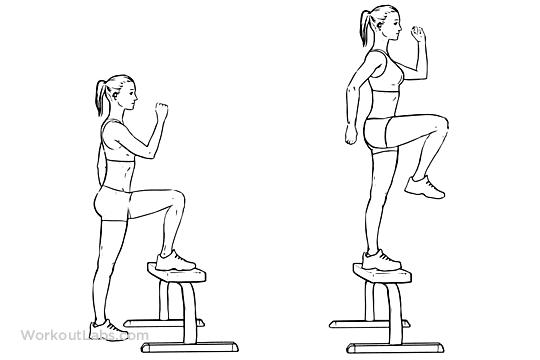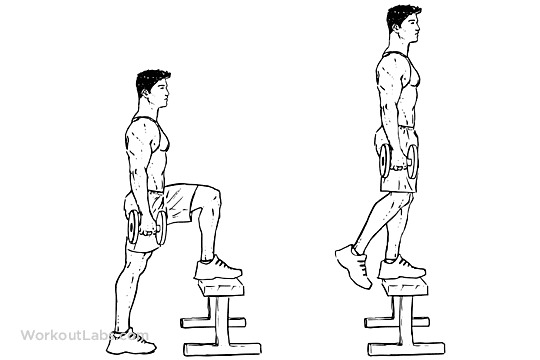The term "step up" means the exercise for the thigh muscles whose movement can be compared to climbing a step. It is an exercise by definition one-sided and with a closed kinetic chain (i.e. it is the body that moves while keeping a limb still).
These two characteristics make the step up an exercise to be included in your routine among the accessory exercises for the lower body.
The intensity of this exercise varies in relation to the height of the step (without exaggerating) and the possible use of dumbbells as weight.

In general, the step up lends itself well to medium-high repetitions (8? 15) or even as an exercise to be included in a HIIT or as a burn? Out for the buttocks.
execution
Regardless of the height of the step, the execution is as follows:
- Stand in front of a raised surface at a close distance. It is possible to position yourself slightly further apart to increase the work of the hip extensor muscles, especially the buttocks, without overdoing it. If you position yourself too far away you end up having the center of gravity too peripheral with respect to the support base and therefore you tend to compensate by bringing the weight forward or giving yourself momentum.
- Place the entire foot (of the leg you want to train) on the surface. Depending on the distance from this, the hip must be flexed slightly. The more distant you are, the more you have to move forward. the knee in any case must be in line with the second metatarsus (it must follow a line that cuts the foot in half) during the entire exercise.
- Push down and back with your chosen leg. The pressure should be applied in the center of the foot, between the heel and the metatarsus, the weight of the body should be felt in this area for the entire exercise. Pushing down should move the rest of the body up and forward, the point of contact will therefore remain the foot of the active leg (a fundamental prerequisite is to maintain balance).
- Extend the knee at a constant speed. Generally we tend to extend rapidly in the first portion of the movement because we tend not to involve the quadriceps from the beginning. the first uses a maximum ROM. Both variants are valid.
- At the same time as the knee extension, the hip must also be extended. The extension must be complete and therefore it is necessary to focus on the buttocks by contracting them to the maximum. Typically these muscles are never exploited in their full ROM and step up offers a combined opportunity at low risk. Here the concentric phase of the exercise ends.
- The eccentric phase consists in repeating the movement backwards, keeping tension on the buttocks and quadriceps until the other foot returns to the ground.
- It is possible to alternate a repetition with one leg and then with the other but it is not very productive.

Muscles involved
The muscles involved are mainly glutes and quadriceps. The hip extension is also given by the hamstrings, but if the hip extension is exaggerated (as it should be done) the work is more on the buttocks.
To maintain balance in a monopodal position, a tonic activation of the gluteus medius and adductors at the hip and also of all the muscles that support the plantar arch is also necessary.
Common mistakes
The most common mistakes are to drop the knee in the valgus position (knee facing medially). As long as the valgus is not exasperated this is not a big problem but the position requires a good work on the part of the ligaments.
A safe choice should therefore be to keep the knee in the previously described position. Another common mistake, probably the most frequent of all, is to help yourself with a plantar flexion with the leg on the ground.
To avoid this, you must first choose a load suited to your abilities and this often leads to a drastic drop in ballast if not the choice of the free body.
A second help can be to place the foot on the ground on a disc in order to keep only the heel in support while the toes are not in contact. This forces you to recruit the muscles of the raised limb.
variants

There are multiple variations. Here are some:
- Use only one dumbbell contralateral to the working leg. This forces the gluteus medius to work hard together with the oblique abdominal muscles.
- Flexing the contralateral hip in the phase of maximum contraction, this allows to stimulate also the contralateral rectus femoris simulating a movement similar to running.
- Do only negative reps if you want to strengthen the tendons. The final eccentric phase of the step up allows an almost total unloading and modifying the height of the step allows to modulate the stress on the ligaments. These two features offer an excellent employment opportunity if you are recovering from an injury or even an operation (always seek the advice of a doctor in both cases).


























